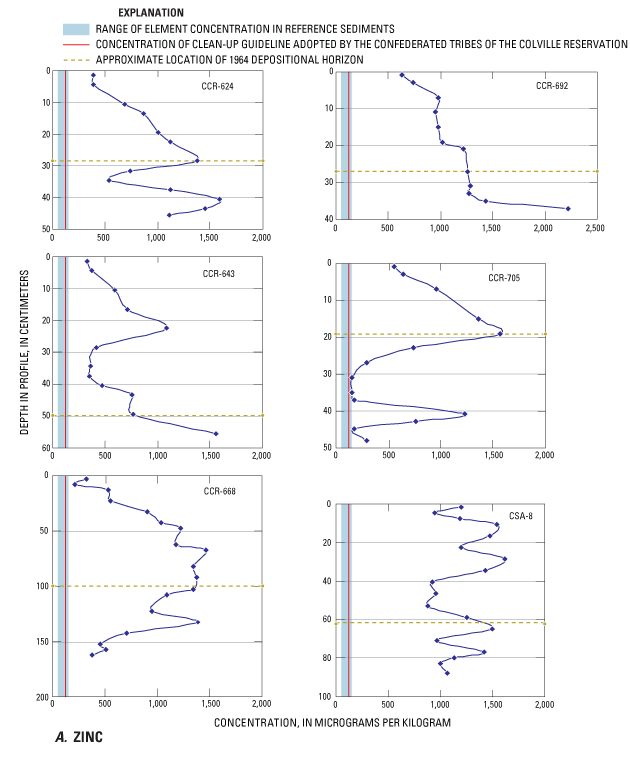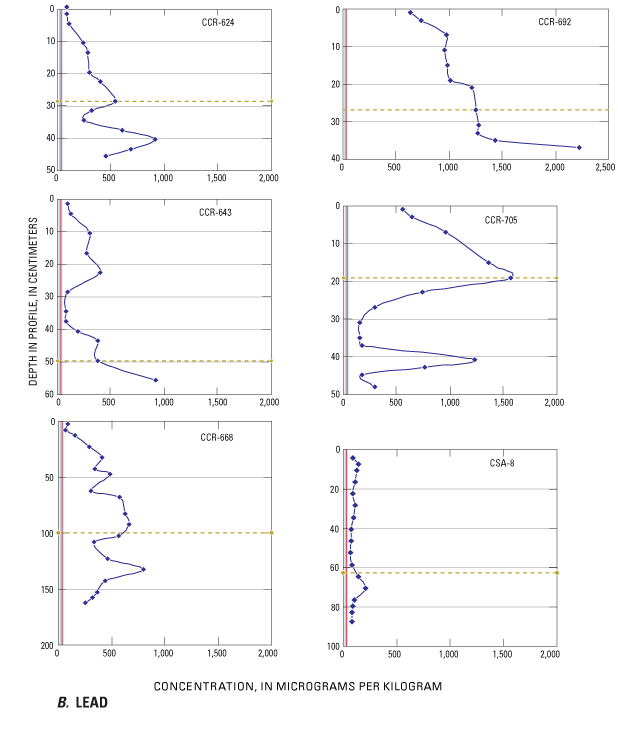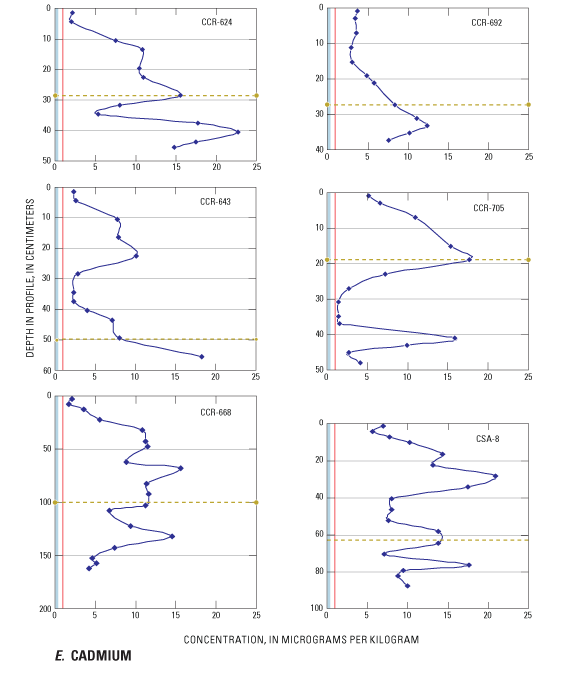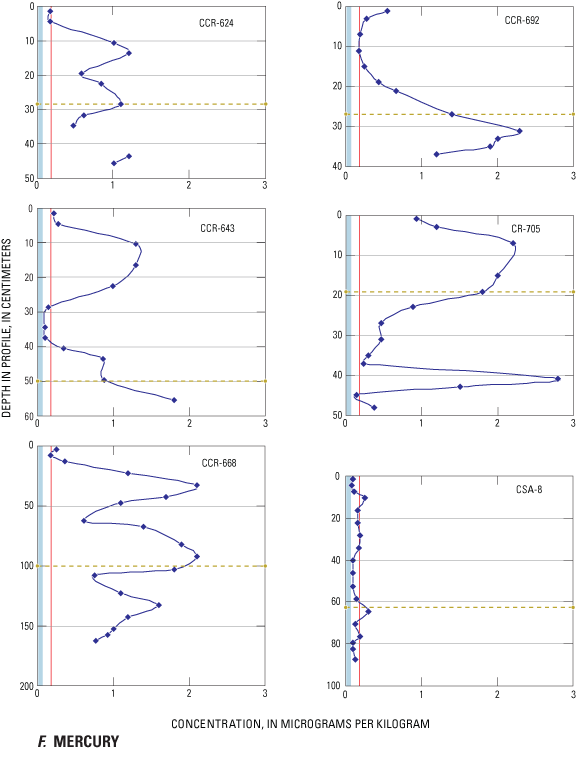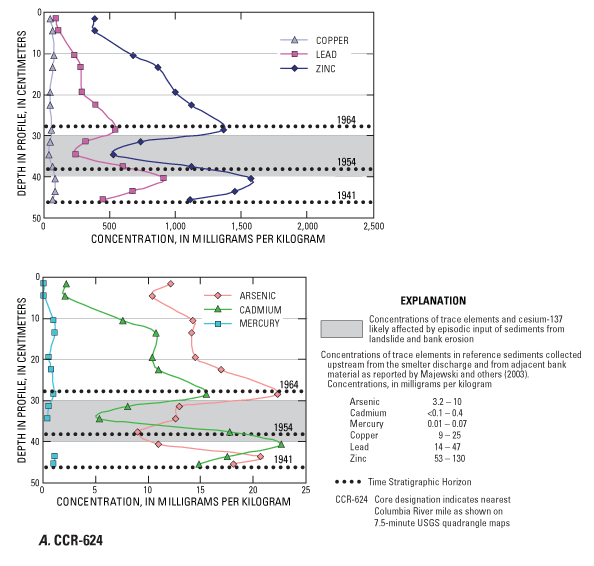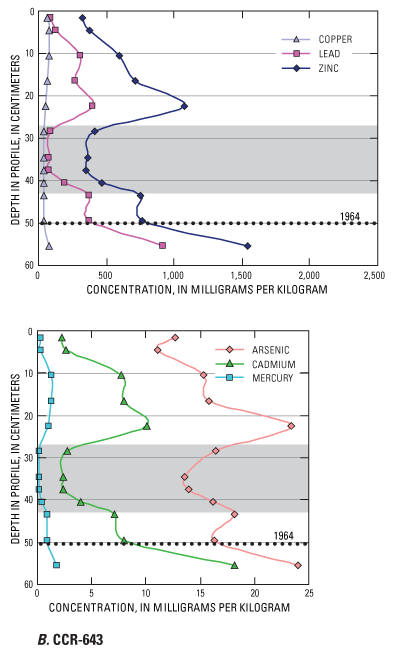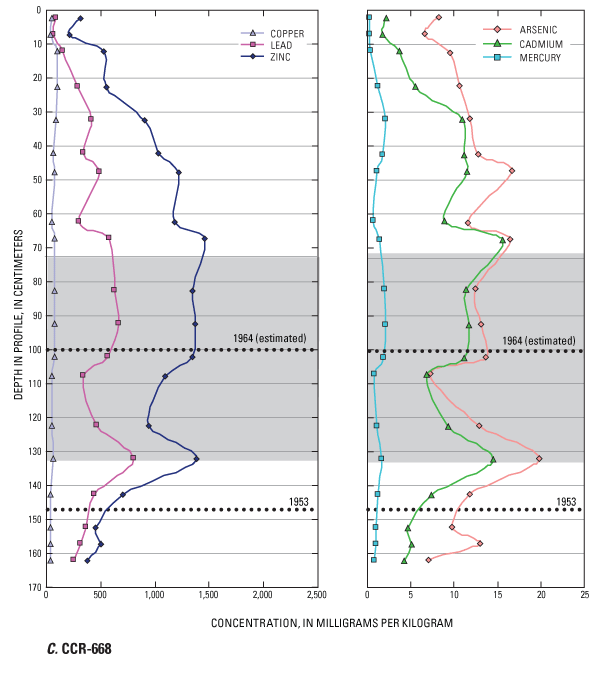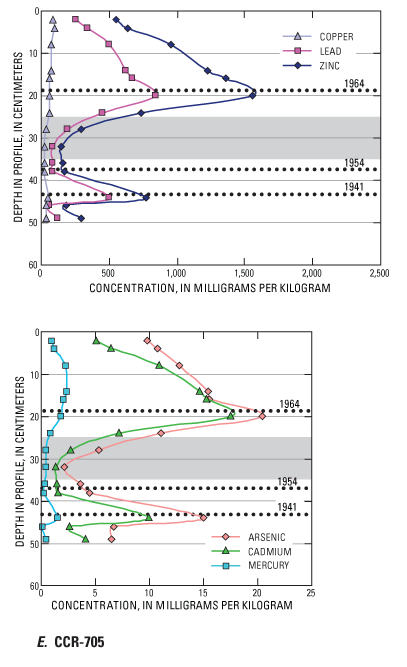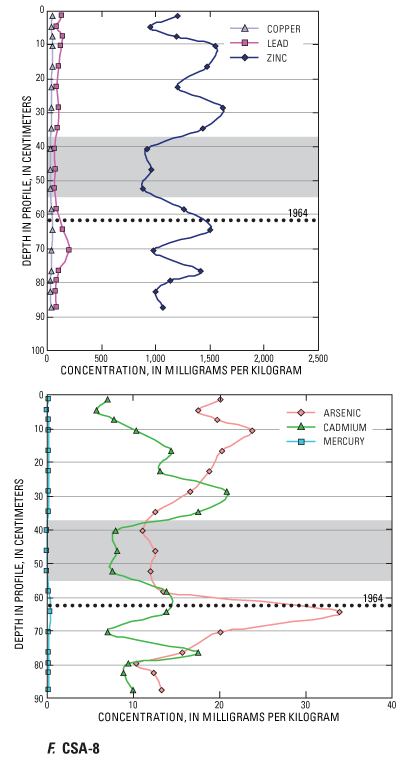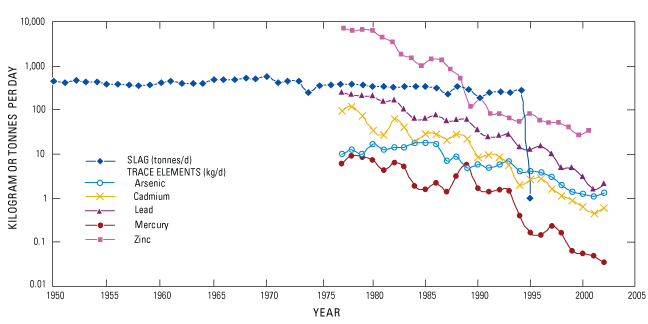U.S. GEOLOGICAL SURVEY
Scientific Investigations Report 2004-5090
Vertical Distribution of Trace-Element Concentrations and Occurrence of Metallurgical Slag Particles in Accumulated Bed Sediments of Lake Roosevelt, Washington, September 2002
Accumulated Sediments in Lake Roosevelt
Description of Cores and Accumulated Sediments
Sediment cores ranging in length from 38 to 164 cm were collected from six sites in Lake Roosevelt (fig. 1 and table 2). The sediments recovered in the cores generally were grayish to dark olive gray in color throughout the core length. Near the surface (0 to 2 cm depth), sediments were often reddish-brown with a 0.2-0.4 cm layer of black material, and mottling was common in the upper 20 cm of cores. Gas vesicles from 0.1 to 0.3 cm were common as was a sulfurous odor. A sand-size particle of slag was noted in the soil-sediment interface of core CCR-705. Organic material such as root-hairs was observed in some intervals.
The pre-reservoir sediments that were encountered were easily distinguished by differences in sediment color and texture. Pre-reservoir sediments were encountered in only one of the six cores analyzed, site CCR-705, which also was the only site located away from the pre-reservoir channel. The base of CCR-705 below 39 cm contained black sediments with organic fragments, such as root hairs. While subsampling CCR-705, a large slag-like particle was observed near the interface of the soil and lacustrine sediments. Pre-reservoir sediments also were encountered at a site near RM 685. The gravity cores recovered at this site contained insufficient (less than 20 cm) lacustrine sediments needed for developing a detailed trace-element profile. About 50 cm of sandy material containing a significant fraction of slag-like particles was beneath the lacustrine sediments. The sandy material was interpreted to be a fluvial deposit of the pre-reservoir Columbia River. Although the interval of lacustrine sediments was insufficient to meet sampling requirements for subsectioning, a sample of the sandy material was retained for analysis of slag (RSS-685). During sampling, the coring equipment encountered hardrock material substantially denting the hardened stainless steel nose-piece of the core barrel at mid reservoir sites CCR-643 and CCR-692 and at the Spokane Arm site CSA-8. The hardrock material was believed to be the pre-reservoir bedrock surface indicating that in the locations sampled, the total thickness of accumulated sediments within the reservoir was less than the 3 m length of the coring equipment. Lake sediments greater than the 3 m length of the coring equipment were not observed while collecting cores from Lake Roosevelt.
Cesium-137 Concentrations and Rates of Sediment Accumulation
Assignment of Time Stratigraphic Horizons
Time horizons were assigned to each core based on the stratigraphic position of significant changes in the concentration profile of Cs-137. Additional time-stratigraphic markers used in assignment of time horizons within the sediment core included (1) the upper sediment surface, assigned the date of sample collection and (2) the lower surface of the accumulated lake bed sediments assigned a time coincident with the initial filling of the reservoir.
Cs-137 is a radioactive isotope of cesium whose presence in the hydrologic environment is directly related to above-ground testing of thermonuclear weapons conducted in the 1950s and early 1960s. Because Cs-137 is rapidly removed from the atmosphere by precipitation and fallout and has a strong affinity for fine-grained sediment particles that accumulate in lake bed sediments, the concentrations profile of Cs-137 in lake sediments can be used to identify sediments deposited at the beginning and end of the period of atmospheric testing of thermonuclear weapons. The period of major atmospheric testing of thermonuclear weapons began in November 1952 followed by increasing numbers of tests in the following years (U.S. Department of Energy, 2000). Substantial concentrations of Cs-137 greater than background concentrations were widely detected in lacustrine sediments beginning in 1954. Undisturbed sediments deposited prior to 1954 do not contain significant measurable concentrations of Cs-137. Atmospheric testing of thermonuclear weapons increased over the years until autumn 1963 when the Limited Test Ban Treaty was signed and atmospheric testing of thermonuclear weapons was halted by most Nations that were testing thermonuclear weapons at that time. A substantial peak in Cs-137 concentrations occurs in sediment deposited during 1963-64 as the result of nearly 100 atmospheric tests that were conducted in the year prior to signing the Limited Test Ban Treaty (U.S. Department of Energy, 2000).
The resulting characteristic or ideal profile of Cs-137 in lake sediments is that of relatively small concentrations in sediment at the sediment-water interface with concentrations gradually increasing with depth to a maximum value (which varies based on geographic location); below this point, the concentration of Cs-137 gradually decreases to a point where its concentrations are either undetectable or decrease sharply to concentrations much less than 0.1 pCi/g or background concentrations (Charles and Hites, 1987). Two points in this profile are useful in assigning time stratigraphic horizons. The location of maximum concentration is indicative of the period of maximum deposition around 1964. The point in the profile below the maximum concentration at which Cs-137 ceases to be detectable or where concentrations decrease well below 0.1 pCi/g is attributed to the beginning of Cs-137 deposition in 1954. Non-ideal Cs-137 profiles that result from physical or biological mixing of sediments as well as variations in sediment source material and wave-induced remobilization of fine-grained sediments from the shallow zones to deeper zones may still provide useful stratigraphic markers for the dates of the onset and peak Cs-137 deposition (Charles and Hites, 1987). Cs-137 profiles in bed sediments have been widely used to determine sediment-accumulation rates (Ritchie and McHenry, 1990; Crusius and Anderson, 1995; and Van Metre and others, 1997).
The concentration of Cs-137 measured in core sediments from Lake Roosevelt ranged from <0.01 to 1.8 pCi/g. The concentration profiles of Cs-137 within cores CCR-643, CCR-668, and CCR-692 (fig. 3) were non-ideal but showed the basic characteristics of ideal Cs-137 profiles in lake sediments. Peak Cs-137 concentrations associated with the suspension of atmospheric weapons testing in 1964 could be identified in all six cores, but often contained short intervals in which the concentration of Cs-137 decreased substantially followed by a return to equal or larger concentrations. The pronounced decreases in Cs-137 concentrations were attributed to the influx of sediments from landslides. This effect was most readily observed in the Cs-137 profile of CCR-705, but also was present in the other cores.
Concentrations of Cs-137 in the lowest sections of the core CCR-705 range from <0.01 to 0.02 pCi/g; this interval (40-46 cm) included pre-reservoir soils and can be used to identify the range of background Cs-137 concentrations in the Lake Roosevelt area. In the overlying sections (34-38 cm), the concentrations of Cs-137 were 0.16 and 0.18 pCi/g, indicative of the influx of Cs-137 from atmospheric weapons testing. However, the concentrations of Cs-137 in the next three overlying intervals (22-32) decreased by 80 to 95 percent to concentrations of <0.01 to 0.04 pCi/g, which were immediately overlain by a section (18-20 cm) containing the maximum measured Cs-137 concentration in that core of 1.2 pCi/g. The intervals in which the concentrations of Cs-137 decrease markedly are indicative of disruption of the normal sedimentation processes and are believed to be the result of the episodic influx of bank sediments. Landslide sediments would be devoid of Cs-137 produced from atmospheric testing of thermonuclear weapons and thus dilute the concentration of Cs-137 in the more steady influx of fluvial sediments to the reservoir from upstream drainage basins. The influx of the bank sediments likely is due to the many landslides that have occurred along the margins of the reservoir (Jones and others, 1961).
The characteristic features of typical Cs-137 profiles in sediments from Lake Roosevelt were present in sufficient detail to assign time horizons to intervals associated with the end of atmospheric testing of thermonuclear weapons, and the beginning of the testing period also was observable in some cores. Maximum Cs-137 concentrations attributable to the 1964 depositional period were identifiable in all cores (see fig. 3); however, the influx of landslide sediments substantially affected the Cs-137 profiles in core CCR-668 and interpolation between intervals containing Cs-137 concentrations of 0.76 and 0.78 were used to estimate the depth of sediments deposited around 1964 (see fig. 3 and table 3). The 1954 time horizon was assigned to the first appearance of Cs-137 greater than 0.04 pCi/g (two times the highest concentration in pre-reservoir soil sediments) and was identified in two cores (CCR-668 and CCR-705). Additional time horizons used in the evaluation of the patterns of historical deposition of sediment and trace elements in Lake Roosevelt include the sediment surface at the time of sampling (2002) and the contact between lacustrine and pre-reservoir sediments (1941).
The sediment recovered in all six cores included at least 60 percent of the reservoir sedimentary record, as peak Cs-137 concentrations exceeding 0.7 pCi/g were present in all cores. The sedimentary record in three cores (CCR-624, CCR-668, and CCR-705) extended through the 1954 time horizon to include 80 percent or more of the sediment record. Core CCR-705 was the only core where the sedimentary record included the contact between lacustrine and pre-reservoir sediments (soil), thereby extending from the time of sampling to the time of initial filling of the reservoir. Although core CCR-624 did not encounter pre-reservoir sediments, the sediment accumulation data indicates that the sediments in the lowest sections of that core were deposited in the early 1940s, thereby providing a nearly complete sedimentary record of Lake Roosevelt. The sedimentary record for core CCR-668 extended to the early 1950s, although the earliest sediments recovered in cores CCR-643, CCR-692, and CSA-8 were deposited at times between 1953 and 1964.
Figure 3. Vertical distribution of cesium-137 concentrations in sediment cores from Lake Roosevelt, Washington, September 2002.
[est, estimate; ft, foot; cm/yr, centimeter per year; (g/cm2)/yr, gram per square centimeter per year; >, greater than]
| Marker interval | Core identification No. | |||||
|---|---|---|---|---|---|---|
| CCR-624 | CCR-643 | CCR-668 | CCR-692 | CCR-705 | CSA-8 | |
| Depth to date horizons identifed in cores (ft) | ||||||
| Total core length including some sediment lost in retrieving core | 48 | 74 | 173 | 38 | 49 | 90 |
| Markers identified | ||||||
| Undisturbed sediment surface 2002 | 0 | 0 | 0 | 0 | 0 | 0 |
| Depth to Cs-137 peak (1964) | 28 | 50 | 100 | 27 | 19 | 62 |
| Depth to first appearance of elevated Cs-137 (1954) | 38 | - | 147 | - | 37 | - |
| Depth to pre-reservoir surface (1941) | 48est | - | - | - | 44 | - |
| Linear estimate of sediment accumulation rate (cm/yr) | ||||||
| Estimate between marker horizon | ||||||
| 1941-2002 | 0.79 | - | - | - | 0.72 | - |
| 1954-2002 | .79 | - | 3.1 | - | .77 | - |
| 1964-2002 | .74 | 1.3 | 2.6 | 0.71 | .50 | 1.7 |
| 1941-1964 | .87 | - | - | - | 1.1 | - |
| 1954-1964 | 1.00 | - | 4.7 | - | 1.8 | - |
| 1941-1954 | .77 | - | - | - | .54 | - |
| Whole core minimum value | .79 | 1.5 | 2.8 | .79 | .80 | 1.9 |
| Mass estimate of sediment accumulation rate [(g/cm2))/yr] | ||||||
| 1941-2002 | 0.42 | - | - | - | 0.53 | - |
| 1954-2002 | .44 | - | 1.6 | - | .45 | - |
| 1964-2002 | .44 | 0.82 | 1.2 | 0.61 | .24 | 0.00 |
| 1941-1964 | >.38 | - | - | - | 1.1 | - |
| 1954-1964 | .44 | - | 3.1 | - | 1.9 | - |
| 1941-1954 | .33 | - | - | - | .38 | - |
| Whole core minimum value | .42 | >.76 | >1.4 | >.63 | .53 | .00 |
Sedimentation Rates
The rates of sediment accumulation, measured as both the length and mass of accumulated sediments between two time horizons within the sediment core are shown in table 3. Sedimentation rates based on length of accumulated sediments are reported as centimeters per year (cm/yr) and are subject to sampling artifacts, particularly core shortening, moisture content, and natural compaction of buried sediments. Compaction of the core within the coring tool barrel caused by friction along the core wall during sampling may reduce the total length of the core as much as 30 to 40 percent (Peter VanMetre, U.S. Geological Survey, unpublished data, 2002). Mass accumulation rates are reported as grams per square centimeter per year [(g/cm2)/yr]. Mass accumulation rates are based on the dry mass of sediments per unit area between time horizons and are not prone to the effects of core shortening and compaction.
Linear estimates of sediment accumulation rate in the sediment cores, based on the observed date horizons, ranged from 0.50 to 4.7 cm/yr, and typically were between 0.77 to 1.8 cm/yr (table 3). Mass estimates of sediment accumulation rates ranged from 0.24 to 3.1 (g/cm2)/yr and typically were between 0.42 and 1.00 (g/cm2)/yr. Within individual cores, the rate of sediment accumulation varied and typically was largest in the lower core sections for sediment deposited prior to 1964. Current rates (2003) of sediment accumulation likely are substantially smaller because the completion of additional dams upstream of Lake Roosevelt on the Columbia [Hugh Keenleyside Dam (1968)], Kootenay [Brilliant Dam (1940s)], and Pend Oreille Rivers [(Waneta Dam (1950s)] have further reduced the sediment input to the reservoir and the stabilization of the reservoir shoreline has reduced the frequency and magnitude of landslides.
Concentrations of Trace Elements in Accumulated Sediments
Concentrations of arsenic, cadmium, copper, lead, mercury, and zinc were high throughout the six sediment cores collected from Lake Roosevelt. Maximum concentrations in the core samples were as high as 2,200 mg/kg for zinc, 920 mg/kg for lead, and 250 mg/kg for copper, with median concentrations of 970, 260, and 53 mg/kg, respectively (table 4). Concentrations of arsenic, cadmium, and mercury were lower; with maximum concentrations as high as 34 mg/kg for arsenic, 23 mg/kg for cadmium, and 2.8 mg/kg for mercury, with median concentrations of 13, 7.5, and 0.58 mg/kg, respectively. Concentration data for 54 elements determined for bulk-sediment samples from the six cores are shown in table 5 (at back of report). The analytical results of the associated quality-control samples, presented in table 6 (at back of report), indicate acceptable levels of bias and variability in the sample analytical data.
Bias and variability of the laboratory data were within acceptable limits. Quality-assurance samples were submitted as double blind samples; the laboratory was not informed which samples were quality-assurance samples nor the specific standard reference material that was used. Bias in the samples were assessed as a percentage of recovery by comparison of the reported concentrations of the standard reference material to the concentrations determined by the laboratory. Variability was assessed by comparison of the relative percentage of difference of replicate environmental samples. Data for the quality-control samples submitted from the field are shown in table 6. The median recovery for all trace elements for which certified or reference concentrations were reported was 99 percent; however, 5 percent of the laboratory analyses were outside the target recovery range of 80-120 percent. The median recoveries for six analyses of standard reference materials for arsenic, cadmium, copper, lead, mercury, and zinc were 94, 96, 105, 96, 100, and 96 percent, respectively. Variability generally was small, the median difference of the replicated environmental samples was 2.4 percent with 3.8 percent of the replicated analyses outside the target range of less than 20 percent difference between the replicate samples. Of the six trace elements of concern, the analysis of lead showed variability ranging from 87 to 124 percent while variability in copper concentration of one of the environmental replicate pairs was different by 46 percent. Review of the laboratory process sheets confirmed the variability in the copper analysis. The deviations observed in the copper and lead data for these samples were not observed among the other quality-assurance samples and thus considered outliers that did not significantly affect the overall acceptability of the data.
[Average concentrations in crustal rocks: Data from Rose and others, 1979. Range of reference: Data from Bortleson and others, 1994, and Majewski and others, 2002. Clean-up guideline: Guidelines from CCT. Clean-up guidelines adopted by Confederated Tribes of the Colville Reservation (2003)]
| Constituent | Number of samples | Concentrations, in milligrams per kilogram (mg/kg) | |||||
|---|---|---|---|---|---|---|---|
| Average | Minimum | Maximum | Median | 10th percentile | 90th percentile | ||
| Arsenic | 84 | 14 | 2.1 | 34 | 13 | 7.1 | 20 |
| Cadmium | 84 | 8.6 | 1.4 | 23 | 7.5 | 2.4 | 16 |
| Copper | 84 | 68 | 18 | 250 | 53 | 32 | 130 |
| Lead | 84 | 310 | 61 | 920 | 260 | 83 | 610 |
| Mercury | 82 | .82 | .08 | 2.8 | .58 | .1 | 1.9 |
| Zinc | 84 | 930 | 151 | 2,200 | 970 | 330 | 1,500 |
| Constituent | Average concentration in crustal rocks (mg/kg) | Range ofreference concentration (mg/kg) | Percentage of samples exceeding upper reference | Percentage of samples exceeding 3X upper reference | Percentage of samples exceeding 10X upper reference | Clean-up guideline (mg/kg) | Percentage of samples exceeding clean-up guideline |
| Arsenic | 2 | 3.2-10 | 78 | 1 | 0 | 9.8 | 78 |
| Cadmium | .1 | <0.1-0.4 | 100 | 100 | 77 | .99 | 100 |
| Copper | 50 | 9-25 | 99 | 26 | 0 | 31.6 | 90 |
| Lead | 10 | 14-47 | 100 | 66 | 20 | 35.8 | 100 |
| Mercury | .02 | 0.01-0.07 | 100 | 70 | 47 | .18 | 74 |
| Zinc | 80 | 50-150 | 100 | 80 | 8 | 121 | 100 |
Concentrations of trace elements in core sediments were compared to reported concentration of trace elements in reference sediments that were collected from bank material adjacent to the reservoir (Majewski and others, 2003) and river sediment collected upstream of the smelter (Bortleson and others, 1994). The largest concentrations in these reference sediments were reported as 10 mg/kg for arsenic, 0.4 mg/kg for cadmium, 25 mg/kg for copper, 47 mg/kg for lead, 0.07 mg/kg for mercury, and 150 mg/kg for zinc. These reference values are intermediate between estimates of natural background concentration, determined as the 95th percentile level, for concentrations determined in the less than 63 micron fraction and less than 4 mm fraction of stream sediments from the area surrounding Trail, British Columbia (Reyes and others, 2004).
Compared to the concentration of trace elements from reference sites, concentrations of cadmium, copper, lead, mercury, and zinc were elevated in nearly 100 percent of core samples analyzed, and concentrations of arsenic were elevated in 78 percent of the samples analyzed (table 4). Concentrations of cadmium and mercury exceeded the upper range of background reference concentrations by 10 times or more in 77 and 47 percent of the samples analyzed, respectively. Concentrations of lead and zinc exceeded reference concentrations by 10 times in less than 25 percent of the samples analyzed. The concentrations of arsenic and copper were least often elevated above concentrations in reference sediments. In most cores, maximum concentrations of arsenic and copper generally were least elevated, typically less than 3 to 4 times the upper range of concentrations in reference sediments. However, at site CCR-692, copper concentrations were substantially larger than in the other cores, with the concentration in many intervals exceeding reference concentrations by 5 to 10 times.
All samples exceeded cleanup guidelines adopted by the Confederated Tribes of the Colville Reservation(CCT) (Colville Confederated Tribes, 2003) for cadmium, lead, and zinc and more than 70 percent of samples exceeded cleanup guidelines for mercury, arsenic, and copper (table 4). The sediment-quality guidelines adopted by the CCT were developed from the consensus based threshold effects concentrations for freshwater ecosystems (MacDonald and others, 2000).
Trace-Element Profiles
The vertical distribution of trace elements was determined by generating a concentration-depth profile for each core for the six trace elements of concern. Similarities and differences can be observed in the concentration-depth profiles of arsenic, cadmium, copper, lead, mercury, and zinc of cores from different locations in Lake Roosevelt (figs. 4A-4F). These profiles show the extent that trace-element concentrations in the accumulated sediments of Lake Roosevelt exceed background reference concentrations and the concentration levels adopted as Trace-Element Clean-up Guidelines by the Confederated Tribes of the Colville Reservation (Colville Confederated Tribes, 2003). The concentration profiles from the sediment cores support conclusions of previous investigators of the widespread occurrence of trace elements in bed sediments of Lake Roosevelt and generally decreasing concentrations in sediments toward the downstream reaches of the reservoir.
Zinc concentrations were largest and covered the widest range of the six trace elements of concern (table 5 and fig. 4A). As found in previous studies, surficial concentrations of zinc were smaller at downstream locations in the reservoir. Concentrations of zinc exceeded the range of concentrations in reference sediments and clean-up guidelines throughout the entire core at all six sites. Eighty percent of all samples exceeded the upper range of reference concentrations by a factor of three. Maximum measured concentrations typically were located in the lower or middle one-third of the cores. In all cores along the pre-reservoir channel of the Columbia River, a trend of decreasing zinc concentrations was observed between sediments deposited near the 1964 time horizon and those in recently deposited sediments. Most decreases were about 50 to 70 percent. The largest decrease was in core CCR-668 where concentrations decreased from 1,500 mg/kg at mid-core to about 300 mg/kg at the surface. Decreasing zinc concentrations near the surface were not as apparent in the core from the Spokane Arm (CSA-8) where zinc concentrations appear to fluctuate about a central value of 1,300 mg/kg throughout the entire core and do not show a clear trend of decreasing concentrations. The influx of bank material from landslides likely explains the intervals of lower concentrations in the middle of cores CCR-624, CCR-643, and CCR-705.
The concentration of lead exceeded the range of concentrations in reference sediments and cleanup guideline throughout the entire core profile at all six core sites (fig. 4B). The concentrations of lead in the cores varied considerably, particularly in cores from the lower and mid reaches of the reservoir but were much less variable in the core from the Spokane Arm. Among all cores, lead concentrations ranged from those approaching concentrations in reference sediments to concentrations greater than 1,500 mg/kg, more than 30 times larger than the upper range of reference concentrations. Concentrations were larger in cores from the upstream locations, however, the concentrations of lead at downstream sites decreased in the more recent sediment near the surface, such that lead concentrations in the uppermost intervals of these cores approached to within several fold the range of clean-up guidelines and reference sediments. The largest concentrations of lead in cores along the pre-reservoir Columbia River channel were in sediments near the 1964 horizon or deeper. Lead concentrations in cores from the lower and mid reaches of the reservoir typically decreased toward the surface by roughly 60 to 80 percent. Lead concentrations in the core from the Spokane Arm generally were lower than most samples from the lower and mid reaches of the reservoir and showed little variation or trend.
Figure 4. Vertical distribution of trace-element concentrations in selected sediment cores from Lake Roosevelt, Washington, September 2002.
Figure 4.—Continued
Figure 4.—Continued
Figure 4.—Continued
Figure 4.—Continued
Figure 4.—Continued
The profiles of copper concentrations were unique among the six trace elements of concern in that an overall trend of increasing rather than decreasing concentrations from depth to the surface was observed in most of the core profiles (fig. 4C). Copper concentrations generally were larger than the range of reference concentrations and clean-up guidelines. Only core CCR-692 shows a definite trend of decreasing concentrations toward the surface, however, concentrations at this site were 2 to 5 times larger than at all other core sites. Copper concentrations in the Spokane Arm typically are lowest among the core profiles; however, the concentration of copper is increasing slightly in the more recently deposited sediments near the surface.
The longitudinal distribution of arsenic in bed sediments of Lake Roosevelt differed from other trace elements in that larger arsenic concentrations were more common at downstream locations, particularly in core CCR-643 (fig. 4D). This distributional pattern of comparatively larger concentrations in surficial sediments at downstream locations in Lake Roosevelt is reverse of the distributional patterns reported by Bortleson and others (1994) and Majewski and others (2003), although the longitudinal concentration gradients in all three studies were small. For cores collected along the pre-reservoir Columbia River channel, arsenic concentrations were largest near the 1964 horizon (fig. 4D) and generally decrease by roughly 40 to 50 percent toward the surficial horizon, although the decrease in core CCR-643 was only about 20 percent. Arsenic concentrations in the core collected from the Spokane Arm of the reservoir (CSA-8) show a trend of increasing concentrations in the more recent sediment horizons. Of the trace elements of concern, the concentration of arsenic in sediment of Lake Roosevelt are the most similar to concentrations in reference sediment. Although arsenic concentrations generally were larger than the range of reference concentrations and clean-up guidelines at all sites, decreasing concentrations in the upper horizons of cores collected along the upper pre-reservoir Columbia River channel (CCR-668, CCR-692, and CCR-705) were less than CCT cleanup guidelines and within the range of concentrations in reference sediments. Concentration profiles from the lower reaches of the reservoir (CCR-624 and CCR-643) were decreasing, nevertheless, the concentrations in the surficial sediments remained slightly elevated relative to the reference concentrations and CCT clean-up guidelines.
Cadmium was the only trace element for which concentrations in all samples throughout each core exceeded the upper range of reference sediments by a factor of three or more and for which all samples exceeded the CCT clean-up guideline (fig. 4E). Sediments in the core from the Spokane Arm of the reservoir generally contained larger cadmium concentrations than sediments from the rest of the reservoir. Cadmium concentrations decreased from the 1964 horizon toward the surface in all cores. Cadmium concentrations in recently deposited sediments from the top of the cores typically were about 20 to 50 percent less than those in sediments deposited near the 1964 horizon.
Concentrations of mercury were consistently larger than the range of background reference concentrations and clean-up guidelines at all sites along the pre-reservoir Columbia River channel (fig. 4F). Mercury concentrations in all core samples from the Spokane Arm exceeded the upper range of concentrations in reference sediments, however, concentrations in only two of these samples exceeded CCT clean-up guidelines. In the cores from along the pre-reservoir Columbia River, large mercury concentrations have been widespread but generally have decreased in sediments above the 1964 horizon, particularly in the most recent sediment intervals. The profile in core CCR-692 shows an increase in mercury concentration in the two most recent sections of the profile, which may be associated with the concurrent large increase in total organic carbon in those intervals (see table 5).
Overall, the depth concentration profiles typically show that concentrations of arsenic, cadmium, lead, mercury, and zinc often were highest in the lower to mid sections (closer to the bottom) and the concentrations of copper often were highest (closer to the surface) in the trace-element profiles. In several individual cores (CCR-624, CCR-643, CCR-668, and CCR-705), well-defined trends of decreasing concentrations of arsenic, lead, zinc, and to a lesser degree cadmium, were observed in the upper sections of cores corresponding to sedimentation that occurred since the 1964 horizon. The concentration profiles for arsenic, cadmium, lead, zinc, and to a lesser extent mercury also clearly show decreasing concentrations in more recently deposited sediments throughout the reservoir as reported by Majewski and others (2003). However, the concentration profiles for copper generally show trends of increasing concentrations in more recent sediments particularly in CCR-705.
Trace-element profiles for the core collected from the Spokane Arm of the reservoir showed several pronounced differences compared to the trace-element profiles in cores collected from along the mainstem of the Columbia River. The most notable differences were the comparatively larger concentrations of zinc and cadmium, and lower concentrations of mercury, lead, and copper. There also was an increasing trend toward the surface in the concentration of arsenic in the upper one-half of the profile and a decreasing trend of cadmium in the upper one-third of the profile; concentrations of copper, lead, mercury, and zinc remained relatively constant throughout the core profile. These results differ from those of Grosbois and others (2001), who reported decreasing concentrations of all six of these trace elements in the upper sections of two sediment cores obtained from the Spokane Arm of the reservoir, as well as for cores from other areas of the Spokane River basin. They attributed the trend of decreasing concentrations in the upper sections of cores to the installation of jig-tailing settling ponds at mine sites and a general improvement in environmental stewardship occurring within the Spokane River basin over the last 20 to 30 years.
The differences in the trace-element concentrations in core sediments from along the pre-reservoir channel of the Columbia River compared to sediments from the Spokane Arm are more clearly observed by the comparison of ratios of the concentration of zinc to lead versus ratios of the concentration of cadmium to mercury (fig. 5). Data for sediments from all cores obtained along the Columbia River plot in a single close grouping whereas ratios of zinc to lead and cadmium to mercury were substantially larger for data from the Spokane Arm and are more scattered and plot away from the area where data from the Columbia River plot. The ratios of zinc to lead and cadmium to mercury typically were about 2 to 4 and 3 to 20, respectively, in the sediments from the cores collected from the reservoir locations along the mainstem of the Columbia River. These same ratios in the sediments from the Spokane Arm of the reservoir were much larger, typically about 10 to 14 and 70 to 100, respectively. Other comparisons such as plots of the relation of calcium-carbonate concentrations or aluminum-titanium concentrations also show substantially different patterns for sediments from the Spokane Arm compared to sediments from the Columbia River channel. Trace-element concentrations in the core collected downstream of the confluence of the Spokane River (CCR-624) shows predominantly the influences of trace-element input from the Columbia River with limited influence from input from the Spokane River basin. The fact that cadmium concentrations at times exceeded arsenic concentrations in deeper sediments from the 1950s time horizons may be an example of input from the Spokane River basin on trace-element concentrations in bed sediments of the lower reach of Lake Roosevelt.
The differences in the relative concentrations of trace elements in the cores collected in the Spokane Arm of the reservoir compared to cores collected along the Columbia River were most likely related to differences in the source areas contributing sediments to the Spokane and Columbia Rivers. Reservoir sediments from along the mainstem of the Columbia River primarily were affected by inputs from the Columbia River whereas sediments in the Spokane Arm of the reservoir were primarily affected by sediment sources from the Spokane River, which includes the Coeur d'Alene mining area (Horowitz and others, 1993).
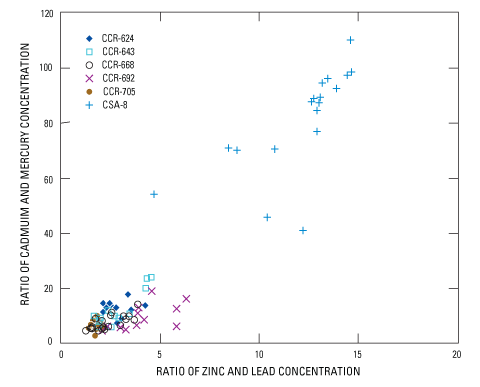
Patterns of Trace-Element Profiles Within Individual Cores
Concentration profiles of arsenic, cadmium, copper, lead, mercury, and zinc showed similar patterns of variation within all cores. The relative concentrations of trace elements remained nearly constant throughout the trace-element profiles. Zinc was present in the largest concentration followed systematically by the concentrations of lead, copper, arsenic, cadmium, and mercury, although there are a several instances in the cores from the Spokane Arm and CCR-624 where the concentrations of cadmium exceeded arsenic concentrations. Within the core sediments, the general pattern of relative concentrations remains constant; even as concentrations were decreasing in the more recent sediments in the upper one-half of the cores. The pattern of relative concentrations observed in the core profiles generally follows relative average crustal abundances of trace elements reported by Rose and others (1979) (see table 4) with the exception that in lacustrine sediments of Lake Roosevelt, the concentration of lead generally exceeds copper by 3 to 4 times.
Because within core variations in concentrations of zinc, lead, cadmium, and mercury were consistent, concentration profiles often were near parallel (figs. 6A-6F). The influx of bank material and its diluting effect on bed-sediment concentrations accentuates variation and the near parallel concentration profiles. Variations in concentrations of arsenic commonly followed the general trends of the other four trace elements but were not nearly as extensive or consistent. The similar pattern of variation in the concentration of zinc, lead, cadmium, and mercury observed in cores from along the mainstem of the Columbia River channel indicates that a single source, such as inflow from the Columbia River, is dominating the depositional patterns of these trace elements throughout most of the reservoir. The profiles often display features that were distinctive to an individual core indicating that localized conditions, such as landslides, had a major influence on the concentrations of trace elements that were being deposited at a particular location. The concentration profiles for each core provide an integrated historical record that incorporates regional and localized influences of the changing depositional concentrations of trace elements at specific locations in the reservoir.
Figure 6. Vertical distribution of trace-element concentrations in six sediment cores from Lake Roosevelt, Washington, September 2002.
Figure 6.—Continued
Figure 6.—Continued
Figure 6.—Continued
Figure 6.—Continued
Figure 6.—Continued
The profiles from CCR-643 illustrate the effect of the episodic influx of sediments from landslides and bank erosion. Concentrations of zinc, lead, cadmium, and mercury decrease by roughly 50 to 80 percent in the intermediate interval between 22 to 42 cm (fig. 6B). The concentrations of arsenic and copper also decrease in this interval but to a lesser extent. Cs-137 concentrations are about 0.6 pCi/g in the sediment intervals near 20 and 42 cm within the profile but decrease to about 0.1 pCi/g in intervals between 20 and 42 cm. Ancillary trace-element concentrations data (table 5) show the concentrations of total cesium, titanium, carbonate, and to a lesser extent calcium, increased in the same interval as might be expected from the influx of landslide material composed of glacial sediments derived from carbonate bedrock. Similar patterns of a sharp decrease in trace-element concentrations attributed to episodic events also were observed in profiles of cores CCR-624, CCR-668, CCR-705, and CSA-8 (figs. 6A, 6C, 6E, 6F).
The trace-element profiles from cores collected along the pre-reservoir Columbia River channel reflect the recorded changes in the effluent discharges from the Trail smelter during the last 30 years. The relative magnitude of trace-element concentrations observed in the core sediments, with zinc>lead>copper>arsenic>cadmium>mercury, generally matches, with the exception of arsenic, available information on trace-element loading rates in liquid effluent discharged from the Trail smelter since the mid-1970s (fig. 7). The concentration of cadmium is larger than arsenic in the effluent discharge, however, the concentration of arsenic typically is larger than the concentration of cadmium in core sediments. This difference may be due to differences in sorption properties of the two elements or additional natural sources of arsenic. Similar information on the concentration of copper in liquid effluent was not available. Since the mid-1970s, the amount of trace-element loading in liquid effluent and slag discharged to the Columbia River has been reduced through a series of improvements and modernizations. Concentrations of trace elements were often highest in sections of the trace-element profiles corresponding to the mid-1960s period. Decreasing concentrations of trace elements in the more recently deposited sediments of the upper one-half of the profiles likely reflect the substantial decreased loading of trace elements in the liquid effluent discharged from the Trail smelter. These trends also reflect the smelter's strong influence on the trace-element composition of bed sediment throughout Lake Roosevelt.
Figure 7. History of slag and trace elements in liquid effluent discharged to Columbia River by Trail smelter, British Columbia, 1940-2000.
(Source of data: Cominco, 1992, 2001; U.S. Environmental Protection Agency, 2003; and William Duncan, Teck-Cominco, written commun., 2004.)
For more information about USGS activities in Washington, visit the USGS Washington District home page .


